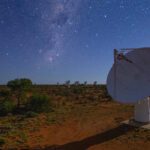Curtin University radio astronomers have been allocated Square Kilometre Array (SKA) pre-construction grants totalling $5 million to develop prototype antennas and systems to investigate the Universe at low frequencies.
The grants, from the Federal Government’s Department of Industry, Innovation, Climate Change, Science, Research and Tertiary Education, are part of $19 million of funding allocated to research and industry organisations to carry out development and verification work over the next three years in the lead-up to the SKA.
Curtin radio astronomers will take a lead role in prototyping and developing technology and scientific techniques for SKA-low, the low-frequency component of the international SKA telescope that will investigate early Universe cosmology, pulsars and transient radio sources.
In Phase 1 of SKA-low commencing in 2017, 250,000 log periodic dipole antennas, each about the size of a TV antenna, will be placed across the Murchison Radio-Astronomy Observatory, located 350km north-east of Geraldton. Most of the antennas will be located in a one-kilometre diameter core region.
Professor Graeme Wright, Curtin’s Deputy Vice-Chancellor Research and Development, said radio astronomy research at Curtin has been well-supported by previous State and Federal Government research grants, and the new Federal pre-construction funding would allow Curtin to continue its critical roles in SKA development.
“This is an exciting achievement for Curtin, as it brings to fruition our strategic planning in low-frequency radio astronomy and shows the University is a big player in the SKA telescope and its future transformational discoveries,” he said.
“Levering off the project Curtin currently leads, the Murchison Widefield Array, this pre-construction work will further strengthen our research capacity in radio-astronomy, and I look forward to seeing Curtin’s high-impact work help make the SKA a reality.”
Professor Peter Hall, Director of the Curtin Institute of Radio Astronomy, said the pre-construction work involves working with international collaborators and Australian industry to develop the antennas and receivers (which may be powered by solar energy), combining their signals in advanced signal processors, and using them in conjunction with the MWA to verify the vision for SKA-low.
“Our pre-construction work involves end-to-end telescope demonstration from the sky through to analysis, to demonstrate how SKA-low will function,” he said.
Professor Hall said Phase 1 of SKA-low will create a striking “sea” of antennas in the central core region with smaller groups of antennas extending up to 100km out from the central area.
“But when these Phase 1 antennas are complete, Phase 2 of SKA-low will begin, which is planned to have 2.5 million antennas, so this pre-construction work is the start of something very big.”
Professor Hall said of the $5 million to be awarded to Curtin, $4 million will go towards the development of SKA-low, while the remaining $1 million will go towards an associated software signal processor project. This second project is led by Senior Research Fellow Dr Stephen Ord, and will demonstrate new ways of correlating, or combining, data coming from the SKA-low antennas.
The Curtin pre-construction work is within consortia consisting of international research organisations including ASTRON in the Netherlands, the University of Cambridge and the National Research Council of Canada. The consortia will shortly submit formal proposals for pre-construction work and Australian funding will flow once the international SKA Organisation accepts the proposals.
Curtin’s Australian funding was received in conjunction with the International Centre for Radio Astronomy Research, in which the University is a joint venture partner.
Industry partners in Curtin’s SKA pre-construction work include Kaelus, Balance Utility Solutions, IBM, NVIDIA, and CISCO.
Photo caption: A representation of the core region of the 250,000 log-periodic dipole antennas placed across the Murchison Radio-Astronomy Observatory, as part of Phase 1 of SKA-low (Image Credit: Swinburne Astronomy Productions/ICRAR/U. Cambridge/ASTRON).


